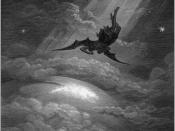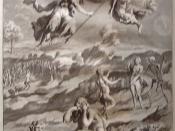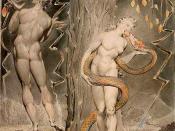The passage under consideration, Paradise Lost, Book 9, lines 1106-1121, deals with an important episode in this work. In this passage, Milton is describing the fig tree, which is used by Indians in Malabar or Decan for shade. He describes that these trees have such wide branches that it creates, ""æa Pillar'd shade/High overarch't, and echoing Walks between; (Paradise Lost, 9, 1106)."àThe branches are so wide that they have created walkways that Indian herdsmen use to shelter themselves from the sun, while they graze their animals. He goes on to further describe how these Indians sew these same fig leaves together, and made coverings "To gird their waist, vain Covering if to hide/ Third guilt and dreaded shame (Paradise Lost, 9, 1113-1114)."àIn other words, Milton is saying that the Indians use the fig tree as shade, but they also use it to cover themselves around the waist, in order to hide their shame of being naked.
Milton, then introduces another image when he says, "how unlike/To that first naked Glory (Paradise Los, 9, 1115)."ÃÂ This is an allusion to the time when Adam and Eve roamed around the Garden of Eden unclothed. This was a time of "naked Glory (Paradise Lost, 9, 1115),"ÃÂ because Adam and Eve were still in a state of innocence, and neither of the two knew what it meant to be naked. As a result, they did not feel the need to cover themselves in order to hide their nakedness. This is why Milton refers to Indians covering themselves with fig leaves sewn together, as being very different from Adam and Eve in their state, before the fall.
Milton goes on to draw another allusion, when he compares the Indians in Malabar and Decan with the Indians...


